01.3.2022 | 1:37 pm
On May 9, 2005, I logged into Microsoft Spaces and wrote a test post. The following day, I wrote an explanation of what this blog would be.
Then, for the next dozen or so years, I wrote something more weekdays than not.
I wrote about weight loss, I wrote about weight gain, I wrote about riding, I wrote about training, I wrote about racing. I wrote about cancer and loss, I wrote about falling back in love and putting myself back together.
I made thousands of friends and I raised millions of dollars for charity. I also revealed a lot of personal flaws (sometimes on purpose, sometimes not) and the fact that I’m work-in-progress, at best.
But in the late twenty-teens, I started writing less, and wrote more sporadically. And now it’s been years since I’ve posted. It’s nagged at me for a while, and I feel like I ought to wrap this blog up with an actual conclusion.
And I promise, this won’t be a cliffhanger.
The Beginning of the End
I’ve asked myself a few times why I stopped posting. These are the answers I’ve given myself.
First, age. When I started this blog, I was in my thirties. My biggest challenge for writing the blog back then was choosing which idea I was going to focus on that day. I kept a list — a list that grew much faster than I could scratch items off — of stories to tell, jokes to center a post around. And then more often than not, I’d wind up writing about something entirely different.
I was incredibly prolific, and a fair number of my posts hold up pretty well. I’m really proud of that.
I started tapering off when I was in my early fifties (I’m 55 as I write this). It wasn’t that I no longer could write. It was more that I no longer felt like I was missing out if I didn’t write. The need just isn’t there anymore. Now, I finish my job for the day and I’m content that I have done enough; I don’t feel an urgency to do something more.
Second, podcasting. If you look at when my blog started winding down, the overlap with my start in podcasting is pretty obvious. This, I think, reflects a transition in what I like doing with my free time. I used to like telling stories, more than just about anything in the world.
In the past few years, I’ve changed. What I care most about now is hearing others’ stories. I love asking a few questions and listening to people talk about their experience and expertise. And, I’ll add, I love hearing other voices than my own.
Podcasting is a medium I love and have a lot to room to grow in. It’s what I want to do right now. You’ll find my current shows at Leadville.fm and MarginalGainsPodcast.cc. I love doing both of them.
Third, humor. It’s tough for me to say this, but it’s true: being funny was core to my blog, and I don’t feel like I’m all that funny anymore. Is this because I’ve told all the fart jokes I have to tell? Is it because I’m more self-aware? Is it because I’m just old and fall asleep at the keyboard most often?
I think it’s all of these, but mostly the last one.
Fourth, blogs are dead. OK, this is not actually one of the reasons I quit blogging. It is, however, basically true.
The Family Part of The End
There are a few things I imagine readers of my blog wondering about — my family, my career, and whether I still ride bikes.
All four of my bio kids live together about 10 minutes away from home. This includes Nigel, who got married a few years ago. They’re all employed with health care plans and 401K plans of their own, and they are all supernerds. Nigel wound up in tech (like me), Katie, Carrie, and Brice wound up in health care (like Lisa). None of my kids care about bikes.
All three of my not-bio kids live in houses or apartments of their own, are employed (Blake and Zac are in tech, Melisa is in health care), and have health care and 401K plans, and are all supernerds, except Melisa who is now a professional bike nerd.
All seven of these kids and their partners are kind, healthy, and fun to be around. The Hammer and I are truly lucky.
What We Accomplished in the End
There are a couple things this blog will be remembered for, and neither of them are jokes.
The story people will remember is Susan. She and I did a pretty brave thing in opening up and telling her story in real time, as she fought cancer. The readers of this blog supported us in a way I will always be grateful for. Then, after she died, readers stuck with me as I figured out how to go on. Thank you for that.
The other thing people will remember is that we raised a lot of money for a lot of charities. More than two million dollars for Livestrong (I have eight signed LiveStrong yellow jerseys hanging in the hallway leading to my office). More than a million dollars for World Bicycle Relief.
I owe a huge debt of gratitude for my readers’ generosity. And I’m also going to take credit for the fact that I orchestrated dozens of innovative, entertaining fundraisers. I arranged giving away dozens of high-end bikes. And trips to exotic locations.
I got Levi Leipheimer, Rebecca Rusch and Patrick Dempsey to race tricycles and cram donuts.
I got Gary Fisher to take someone on a bike tour of San Francisco.
I sent people to France with Andy Hampsten.
And I assure you, those contests and that fundraising approach weren’t just handed to me.
The Job Part of the End
I didn’t talk about job stuff much in this blog. That’s because I made some big career mistakes that I wasn’t all that keen on talking about. Specifically — and this is while I was cheerfully posting on a daily basis — I took a big career gamble on a small company.
The gamble didn’t pay off, everyone took multiple paycuts to keep the company afloat and I found myself struggling financially.
So I found another job — a good one this time, but I stayed only a short time because I was lured to what I thought was a dream job working for a good friend. But it wasn’t a dream job, and the friend wasn’t that good of a friend. In fact, that job messed my sense of self-worth up pretty disastrously. To the point where I am not certain I have yet recovered. I know for sure that it changed me permanently.
During this tough part of my career, I had this great idea: reach out to the nonprofits I had raised millions of dollars for. No doubt they’d jump at the chance to hire someone who’s raised more for them than any single other person, right?
Wrong.
It was a bit of a gut-punch to find that nonprofits I had put an incredible amount of creativity and work into…didn’t think I was worth hiring.
In the end, however, things worked out: one of my friends pointed me out to Adobe. I’ve now been there for four years as a Comms Guy; it’s the best place I’ve ever worked. By a lot.
The End of the End
I sometimes cringe that I named this blog “Fat Cyclist.” I was trying to be self-deprecating and fun, but I was missing a pretty important opportunity: people came to this blog wondering how as a big person they could still have fun on a bike, and instead they found a lot of hand-wringing from a guy who has trouble keeping off thirty pounds.
To the people who were looking for something more than what I gave, I’m sorry. I wish I could change that.
That said, a lot of us did a lot of good together, and a lot of you were incredibly kind and supportive as I wrote stupid stuff and serious stuff and fake news and stupid reviews and shaggy dog-style race reports.
Thank you for reading.
PS: Lisa gave me a quilt for my birthday last year. It may be my single favorite possession. 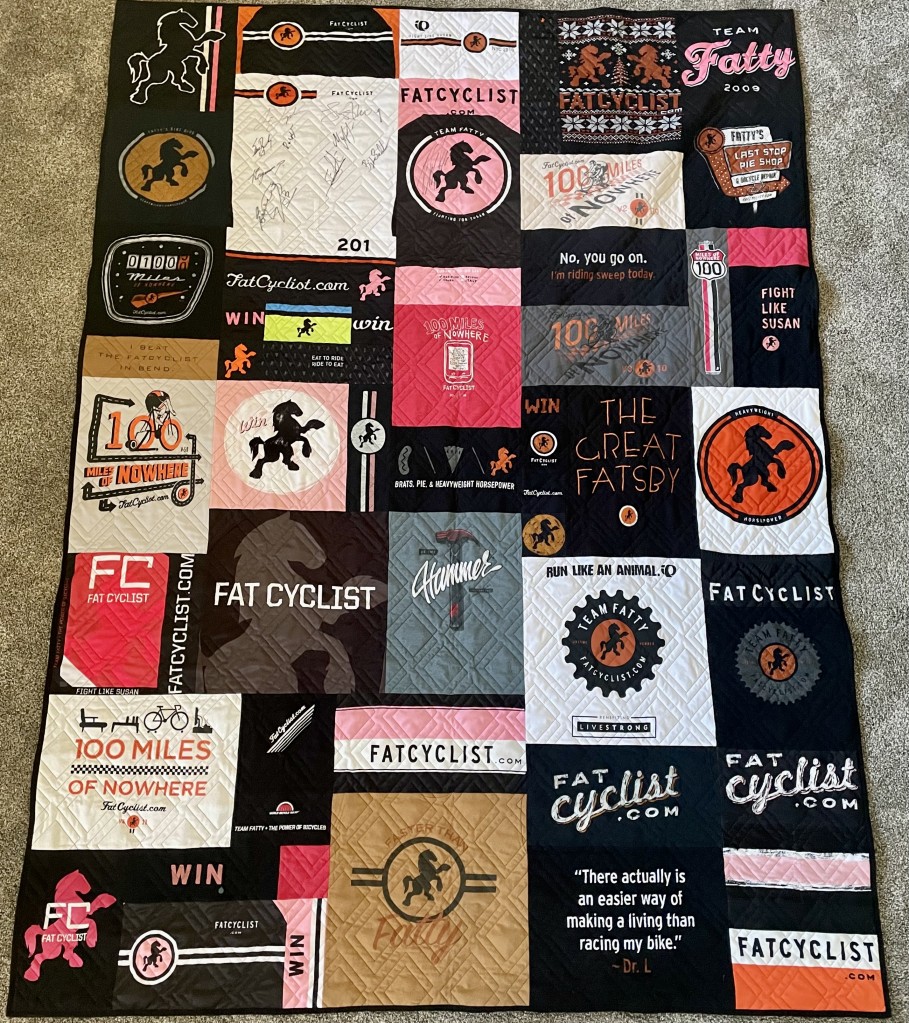
Comments (103)
01.3.2019 | 12:58 pm
Hi there! If you’re one of the 46 (!!!) people who filled out my form expressing interest in the weight loss challenge, you should have received an email from my Gmail account with the subject line “First steps for Fatty’s 2019 Weight Loss Challenge.” If you haven’t gotten that, check your spam folders and whatnot. If you filled out the form and still can’t find it, leave a comment and I’ll re-send it to you.
Love,
Fatty
Comments (2)
01.1.2019 | 3:45 pm
January 2 AM Update: 30 of us have filled out the “I’m interested” form so far, which is not the same as actually registering, but it’s still way beyond (about 3x beyond, to be honest) what I expected. Clearly, I’m not the only one who has gotten too fat for his fat pants.
If all of us actually pay up, that’s $1500 I’ll be donating to Camp Kesem. And since the company I work for does matching on donations, that will turn into $3000 for Camp Kesem. And that makes me super happy.
It’s not too late to sign up. Lose some weight, do some good!
Hey, Happy New Year to you. I hope your January is off to a splendid start.
As for me, well, I’ve kinda been taking it easy on the whole “diet” thing. By which I mean I’ve gotten about as fat as I’ve been in a decade. Maybe more. Specifically, a week or so ago I weighed myself and was horrified to discover I weighed 180 pounds. My reaction was to begin dieting immediately, by which I mean that I have eaten continuously, bringing myself into a perpetual food-induced stupor.
It’s time to turn this ship around.
If you’ve kinda let yourself go they way I’ve let myself go…well, maybe we can help each other get back on track with a little coopetition. Which is to say, if you’ve got at least 15 pounds you’d like to get rid of before summer and you think a friendly competition might help you do it, I think I’ve got just the thing.
Why I’m Doing This and Why You Might Want To, Too
I know I need to lose some weight. I also know a few other things about myself. I’m a competitive soul; I love to win. I’m also a cooperative soul; I love to help others win. I stay engaged — focused — over the long haul when I have accountability, incentive, a finish line, and the prospect of fun.
I think these traits are pretty common. So I’ve contrived a weight loss challenge that I think will keep me on track, will be fun, has serious accountability, has real incentive for me to not bail, and will do the same for the folks who join me.
Here’s How It Works
I’ve done a number of weight loss challenges before. The ones that have worked (for me and others) have had some common elements. They’re easy to understand. They have a carrot and stick. They require frequent accountability. And they do something positive, beyond the competition itself.
So here’s the basic notion of Fatty’s 2019 Weight Loss Challenge: between now and April 20, 2019, you vow to lose at least 15 pounds (if you have less than that to lose, you should find a different challenge). Every Friday, you log your weight in a spreadsheet every challenge participant can see. And if you don’t, you’re out of the contest. That’s the accountability part.
But there’s money involved — a $150 ante. Part of that will go to Camp Kesem — a charity that’s had life-changing results for my own children. The rest will get divided among those who hit their goal, or at least keep trying.
And of course, there’s a community aspect — I’ve set up a Facebook group for those who enter, where we can celebrate victories, encourage each other when we’re having a tough time, and complain about how hungry we are when we need to complain about how hungry we are.
The Rules
- To be part of the challenge, you must first apply using the form linked here, then once accepted, pay a $150 entry fee (Venmo or Paypal, I’ll email you the info when I collect the form) to show your commitment. I know, that seems like a lot. It’s meant to be enough that people won’t just join casually, and enough that it will be an incentive to stay in and keep trying.
- $50 of your join-in goes straight to Camp Kesem. I’m a huge fan of Camp Kesem, which provides free week-long camps to kids whose parents have (or have had) cancer. My own twin daughters have been to it every year since they were eight, and I’ve watched them be helped by it when they needed help. Now I’m watching them want to pay it forward, helping others.
- The first official weigh-in is January 12. If you’re not registered by then, it’s too late.
- You must weigh-in every single week by Friday, posting your weight on the Google Sheet I will share with participants.
- If you do not weigh in, even skipping just once, you are out. If you know you’re not going to be able to weigh in on a Friday, weigh in early. No excuses, no exceptions. Almost certainly, someone (maybe me!) will get hurt, or will have a family emergency, or something else. I can’t / won’t be making those kind of judgement calls.
- At the end of the contest (soon after the final weigh in on April 20), the remaining money (the money that did not go to Camp Kesem) will be divided up as follows:
- 75% of the money is divided equally among people who hit their target weight
- 25% of the money is divided equally among people who did NOT hit their target weight, but did not give up
Notice that I don’t have anything here about how to do your diet. That’s up to you.
An Example
As a thought experiment (and to help me make sure I have this thing imagined reasonably correctly), let’s walk through how this might work.
To keep math easy, let’s say 10 people enter. That creates a pool of $1500, of which $500 goes to Camp Kesem. Now the pool is $1000.
Let’s say that of the 10 people, 2 exit the contest — maybe they are embarrassed to post the fact that they are actually gaining weight — for some reason. They forfeit their entry, so the pool remains $1000 for the remaining 8 people to split.
Of the 8 people who faithfully post each week to the end of the contest, let’s say that half hit their goal (mine is 160, a 20-pound loss between now and April 20), and half don’t. The four people who hit their goal split 75% of the pool, meaning $750 gets split among the four people. They each get $187.50 back — a profit of $37.50.
The four people who didn’t hit their goal but kept trying split the remaining 25%, so they each get $62.50. Not as much, but they’re rewarded for trying, and they know that they made a nice donation to Camp Kesem.
Of course, there are some weird possibilities that occur to me:
- What if everyone hits their goal? In that case, 100% of the pool gets divided equally.
- What if only a small number don’t hit their goal? Suppose in the above example only 1 person doesn’t hit their goal while 7 do? The person who doesn’t hit their goal would make more money than those who do hit their goal. Well, I think the odds of that happening are slim, but it’s possible. I guess for myself I’d rather get less money back and hit my weight goal than not hit my goal and get more money.
- What if people are dishonest? Your weigh-ins are honor-based; there’s no way I can stop you from lying from start to finish. That seems like a lot of work, however, to make a very small amount of money.
It’s not perfect, but I’m excited for it. And I hope that there’ll be about 5 – 10 more people who are interested in playing, as well (though honestly I’m OK with just a couple of us doing this).
If you want to play, fill out this form (it’ll take less than 3 minutes to do) and we’ll go from there.
Let’s have a fast and light 2019, OK?
Comments (26)
10.23.2018 | 11:38 am
A note from Fatty: Be sure to read part 1 before you read this part.
Melisa and Lisa had gone. They were going to be running around Turquoise Reservoir, coming back across the road in eight miles or so.
Which gave me plenty of time, I figured, to go pack up Lisa’s and my stuff at our hotel, check out, and then go get Blake and Jeff. We’d then be able to meet them and cheer them on at several more points on the way to the finish line.
I hustled, picked everyone up, and got to where we expected to see them. And no sooner had we started looking up the trail for them than they came running out:
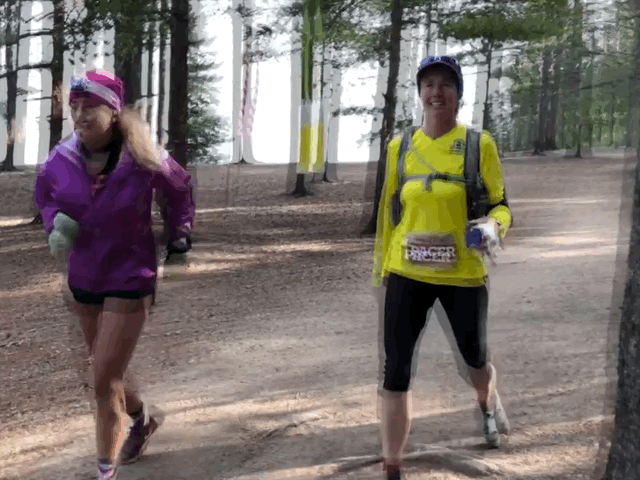
Melisa was smiling! And moving at the pace — as you can see — of a fast walk! And she was there minutes sooner than we had expected her.
She was 95 miles (my guess) into this race, and moving as fast as she needed to.
Everyone’s spirits soared.
“We’ll see you soon!” we cheered as they crossed the reservoir road and started down the other side.
But by the next time we saw her, things had changed. A lot.
Down
We had to drive a little bit of a circuitous route to get to the dirt road that connected to where we’d see them again, but I’d stopped worrying.
Then we saw Melisa, and everyone started worrying again.
The happy, still-sort-of-running Melisa was gone, and in her place was the suffering, every-step-is-agony Melisa.
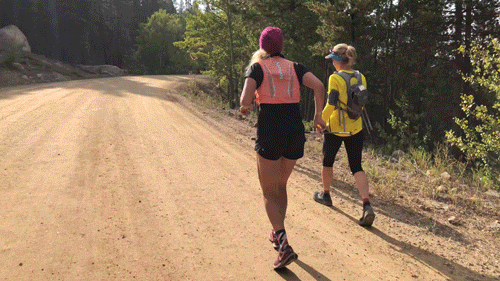
The short-but-steep downhill had been a last straw of sorts for Melisa’s feet.
Still, we walked with the two of them, cheering them on. Staying positive. Being encouraging.
“YOU AREN’T HELPING,” Melisa said. “I can tell that you’re all just walking, so GO.”
Banished, we left Lisa and Melisa to their misery. We’d have to content ourselves with tracking them on Lisa’s phone’s Find-a-Friend.
At the Top of the Boulevard
We drove to the top of the Boulevard — where the dirt meets the road, signaling you’re in the homestretch of the race — and waited. Occasional runners would come by, all of them a mix of pain and elation. Each time one came by, we’d cheer and the course marshal — carrying a bongo drum — would hammer out an awesome beat.
I took turns looking at my watch, looking at Lisa’s dot on Find-a-Friend — willing her to reach the turn that meant they were on the 2-mile-long Boulevard climb — and answering the dozens of texts coming in from family and friends, asking about how Melisa was doing.
From time to time, I’d text Lisa, asking how things were going, and then I’d relay her reply to everyone with me.
This was my first experience being an anxious racer crew, but I’m pretty sure I made up for a lifetime of it in the hour (or two? or ten?) we stood there.
Rejoining
It’s tough to watch a dream fade.
As time went by we went from, “She’ll get it” to “She has a chance” to “Who cares about time? The distance is what matters.”
10:00am — the official finishing time — came and went.
The bongo drum-playing course marshal apologetically said, “I have to go help with course cleanup,” and left.
Lisa’s blue dot was at the bottom of the boulevard; it was difficult to tell whether it had moved in a while.
I was looking at it when Lisa texted me, “We’re going to be a while.”
I texted back, “Is it OK for us to come down and walk up with you?”
She replied, “Melisa says it’s OK.”
We all started walking down, except Jeff, who broke into a run. Which was adorable.
The Walk
We caught up with Melisa and Lisa and began walking with her. 10:00 had come and gone, and 11:00 — the time racers need to hit to get their name on the official finishers’ list — was coming up fast.
Nobody mentioned time.
Sometimes we tried to talk; most of the time we were quiet.
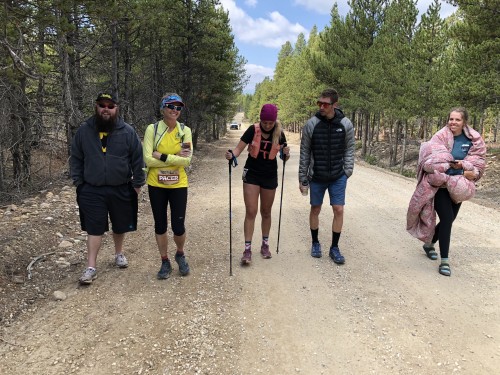
Lisa would ask, every few minutes, if Melisa wanted something to eat, or something to drink. After one of these questions, Melisa said, “YOU’RE NOT DOING A GOOD JOB OF PACING ME. EVERYONE ELSE PACED ME BETTER THAN YOU.” I started laughing, then realized Melisa wasn’t making a joke.
Lisa looked hurt, but could tell it was just pain talking.
Melisa would take a step, plant her poles, then take another step. Baby steps. Not quite one mile per hour.
Roughly one zillion people were texting me, asking what was going on. I did my best to keep up. Later, Melisa would tell me that her main memory of me from the day was that I was just texting all the time.
But I wasn’t just texting. I was also taking pictures.
At which point she tried to do her usual smile-for-the-camera smile. “Cut it out,” I said. “Just ignore the camera.”
And then I got the best, most honest pictures of Melisa you could ever see.
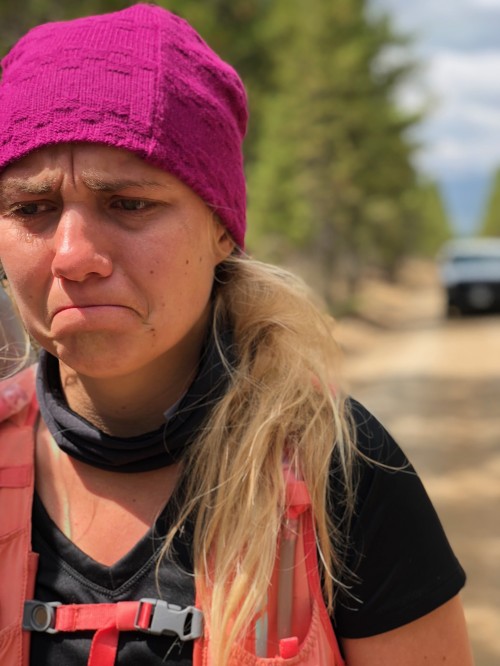
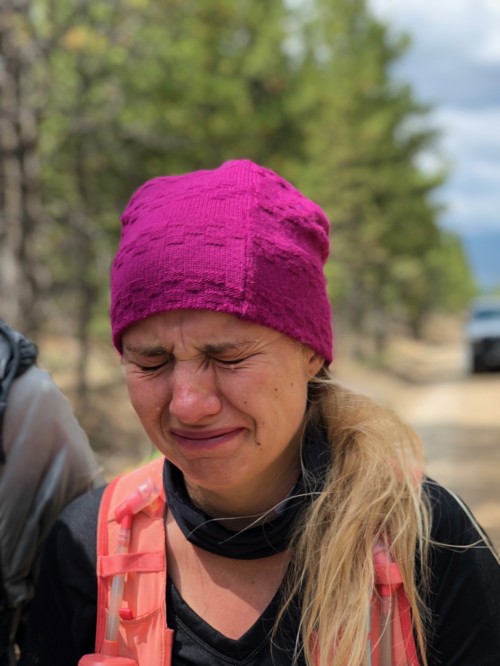
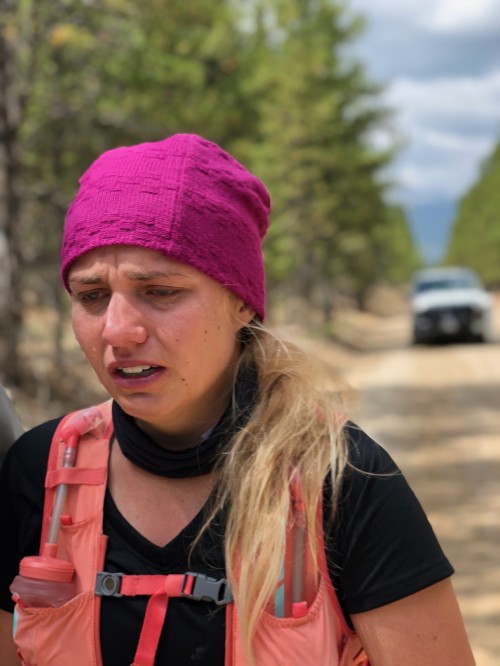
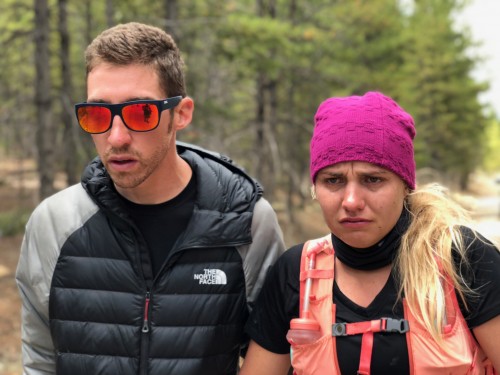
That’s what giving everything you’ve got, and then going way beyond that, actually looks like. It hurts like hell and it’s no fun at all.
And it doesn’t — at least at the moment — feel glorious or brave or extraordinary. The people around you might see it, but you don’t see or feel it yourself.
The Finish Line
Something you probably didn’t notice in those photos is the white truck in the background. That’s the EMT truck. The sweep truck. It stayed a respectful 50 feet behind Melisa for close to three hours while she walked the two miles up the Boulevard. Though it did pull up once when Melisa stumbled. “If she can’t stay upright on her own I need to pull her,” the woman said.
A fair demand.
So Melisa kept walking. Slower, but still going. I looked at my watch and saw it was 12:30. So the awards ceremony was going on. Who cares.
The woman in the truck pulled up and said to Lisa and me — not in earshot of Melisa — “You should know that the timing mat and finish line arch and the bleachers have been taken down. The street’s open. She’s doing this strictly out of her own determination.”
We understood. That had been true for a while.
But Melisa was going slower. She was still moving forward, but so slowly now. You couldn’t walk that slow if you tried. And she still had about 2/3 of a mile to go, even once she reached the pavement.
I couldn’t imagine her walking that much further. I just couldn’t. She was making walking motions, but she wasn’t really moving.
And then a truck pulled up. It was a man from Life Time.
He walked up to Melisa and said, “Everyone knows this race is more than 100 miles. You’ve gone 100 miles, and this is your finish line. You’ve finished this race.”
And he gave her a bouquet of flowers, and a finisher’s medal. And a hug.
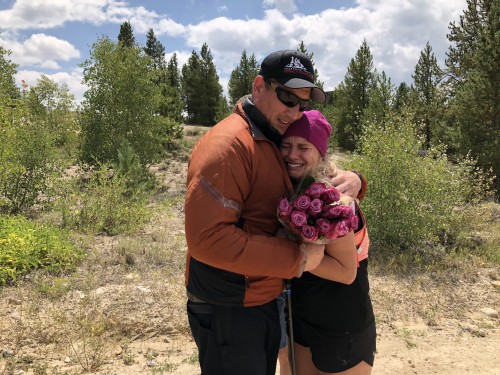
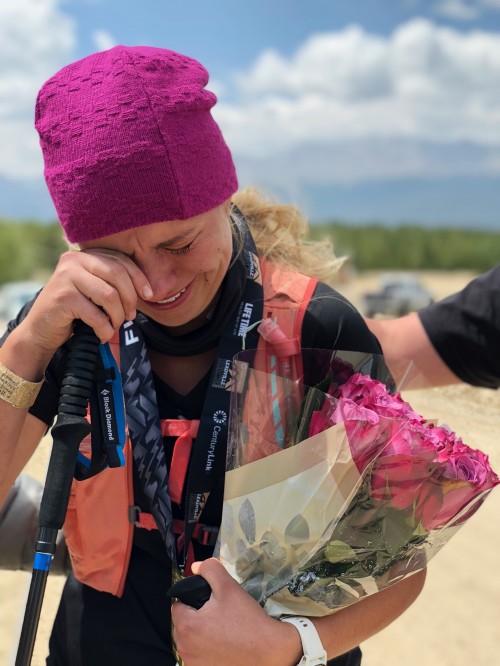
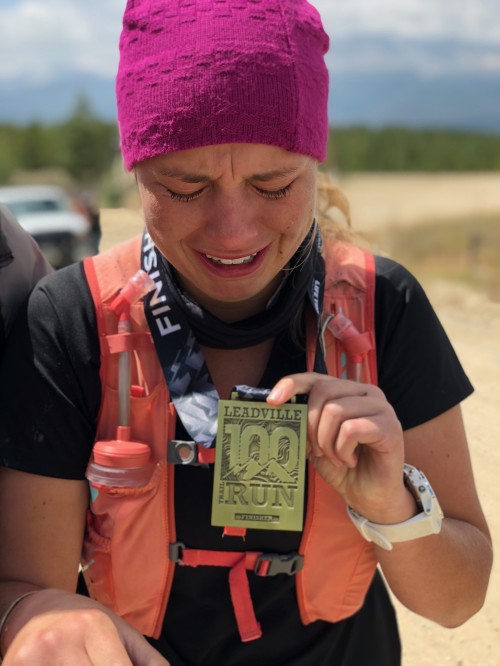
The Leadville 100 Trail Run results page shows Melisa as making it to the Mayqueen checkpoint, but not the finish line. The 2018 Leadwoman results page doesn’t show her at all.
Which goes to show, results pages don’t know shit.
Comments (36)
10.22.2018 | 3:03 pm
A couple weeks ago, The Hammer and Melisa did a local endurance run/race together: The Corner Canyon Ultra Trail Run.
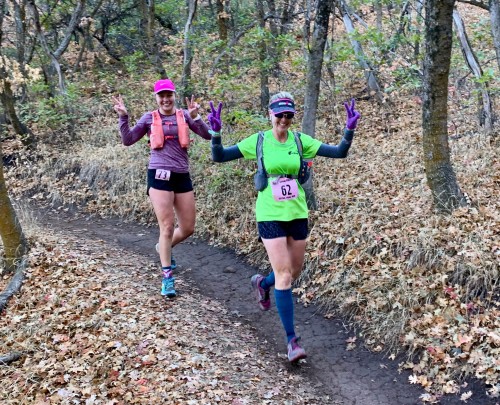
They did the 50K together, and had an awesome time. Although there was a photobomber who managed to get into the frame of one of the official photos:
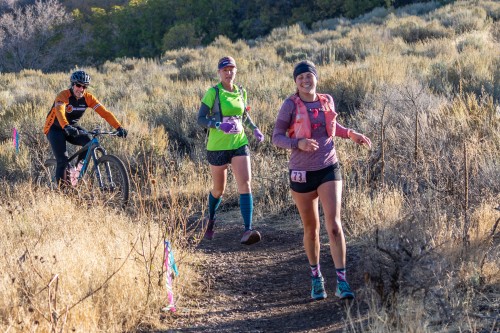
Lame.
Anyway, even after doing this incredibly tough run, they were both happy and strong and feeling great.
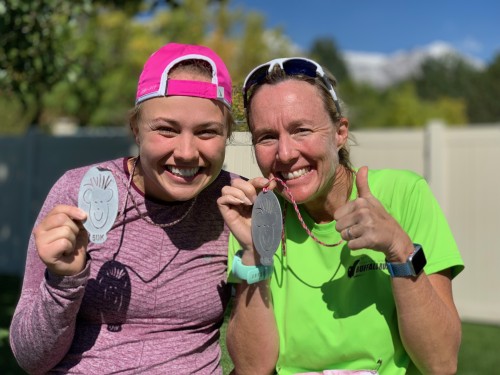
This post is not about that race. Because what would I even say beyond what I just said?
This post is about another run, one which I also witnessed only as a spectator.
But for this race, wow. I’ve got a story. And some photos.
And I’m pretty sure you’re going to cry at the end of it.
The Setup
Immediately after the 2017 Leadville 100 (like, while we were still in the finish line area), Melisa told us she wanted to race the Leadwoman in 2018. We weren’t really surprised; it had been on The Hammer’s bucket list for a long time, too.
For those of you who aren’t familiar with the Leadwoman / Leadman, it’s not a single race. It’s a series of races. You have to complete the Leadville Trail Marathon (in June), the Silver Rush run and/or mountain bike race (July), the Leadville Trail 100 MTB race (2nd Saturday of August), the Leadville 10K (day after the Leadville 100 MTB), and the Leadville Trail 100 run (1 week after the LT100 MTB race).
And through the summer, Melisa had done all of them, right up to the Leadville Trail 100 run. In fact, on the starting line of the Leadville 100 trail run, she was the second-place woman in the series and set up to be the youngest woman to ever complete the Leadwoman.
The Hammer and I came up to Leadville (even though we had just left it a few days earlier) to crew for her and cheer her on.
Melisa had started strong, building up a nice buffer in the first forty miles of the race, going into the Twin Lakes aid station. She was happy and excited for the next twenty miles, which played to her strengths: speed-hiking and climbing.
After she left the aid station, we went back to town, went on a fun mountain bike ride together, got a pizza, and everyone else went back to Twin Lakes while I went back to the hotel room to do some work stuff I was behind on, and to text updates to everyone of Melisa’s progress according to the inReach Mini she was carrying (you could get and send text messages from the aid station, but that was about as connected as the place got).
At first, things seemed fine. I got lots of Powerpointing done and texted occasional updates to Lisa, Blake, and Jeff (Melisa’s boyfriend).
Then it seemed like her dot slowed down. A lot. And it took a long time for her to get to the turnaround timing mat.
I stopped getting any work done and just sat there at the computer, texting Lisa and constantly refreshing the GPS page (not that this did any good, because the tracker sends a ping only once every ten minutes or so).
But Melisa did it. She came back into the Twin Lakes aid station with about 20 minutes to spare before the time cut would sweep her off the course. It had been a harder segment than she’d expected, which seemed natural. This was the first time she’d done more than fifty miles, so how could she have known what to expect?
She took off with her pacer, determined to finish the final forty miles of this race.
The Hammer came back to our hotel and we went to bed, not bothering to set an alarm; we weren’t slated to be on duty again ’til the final five miles of the race, when Lisa would be pacing her.
And that’s where my story begins.
Wake Up
At three in the morning, more or less on the nose, Lisa suddenly woke up, her mommy spidey-sense on full alert. She looked at her phone. Nothing.
One second later, she got a text. She read it and said, “Wake up.”
“I’m already awake,” I said. “What does the text say?”
“It’s from Blake,” Lisa said. “Melisa wants me to crew for her at the last aid station and pace her for the last 13 miles.”
“I wonder what changed,” I said, but didn’t really wonder. Melisa was suffering and wanted her mom. The single most natural thing in the world, really.
The Hammer was up, putting together a camelbak and running clothes.
“I don’t know what to give her at the aid station,” I said. “We weren’t planning on this.” Frankly, I was dismayed at how unprepared I suddenly felt. I’m used to being crewed for, not for doing the crewing. And I don’t know anything about crewing for runners. And we hadn’t been given any instructions on what Melisa wanted or expected from her crew.
So we threw together everything we had with us, foodwise (a fair amount; Lisa had brought along quite a bit of just-in-case gels and chews and drinks and stuff) and headed out to the Mayqueen aid station, 87 miles into the race.
Yellow Pants
You know how there are certain moments in your life that feel like they’re going to stick in your head forever? I had one of those at Mayqueen. We had to park far away from the aid station itself, due to the long line of cars along the road, where other crews had parked their cars. It was 5:30 in the morning and The Hammer and I were worried we weren’t going to get to the aid station before Melisa did. So we ran, each of us carrying one handle of the plastic bin we had thrown together with food and clothes we’d put together for Melisa.
It was very dark. And cold. And foggy. And there was a tense urgency we were both feeling, up against the scrambled-brain background that too little sleep brings.
We got to the aid station at 5:55am. Lisa checked and found Melisa hadn’t come through yet. So that was a good thing.
Except of course it wasn’t. She only had five minutes ’til the cutoff, which meant she was cutting it very close.
No, wait. We’d gotten our numbers wrong. The cutoff time for this aid station was 6:30am. Melisa still had more than half an hour until the cutoff.
We unpacked what we brought close to the tent, figuring Melisa would want to go in and warm up for a minute, then stood waiting, staring up the road, willing Melisa to come running toward us. Unable to know how close she actually was, since the inReach tracker battery had evidently died during the night.
After a few minutes, I couldn’t bear to just stand there anymore. “I’m going to walk up the road a little,” I told Lisa. “That way when Melisa gets close I can flag her down and guide her over to where you are so she won’t have to pick you out of the crowd.”
I walked toward the start of the aid station lane, peering forward, hoping the next person I’d see would be Melisa. Noticing that every single person standing on both sides of the road was also staring toward the intersection in the road, also willing their runner would be next.
I got to the turn, where the course turned left off the road and into the aid station lane. I looked at my watch. 6:15.
For the next little eternity, there would not be a single minute that would go by without me looking down at my watch. To be more accurate, there would not be a half minute that would go by without me looking down.
6:24. There are now markedly fewer people in the aid station lane than when I got here. No longer a crowd. Just worried crews.
6:25. I’m starting to prepare my “87 miles is incredible” speech. It’s a short speech (in fact, that’s the whole speech), because I know I wouldn’t want to hear a long speech if the circumstances were reversed.
6:26. I’m really going to have to give that speech, aren’t I? I don’t want to give that speech. I’m just not going to say anything. She doesn’t need to hear me say anything.
6:27. A woman in yellow rain pants comes up and tells the few of us staring up the road, “I’m going to start walking toward the timing mat. I’m going to walk very slowly, but your racers have to get across the mat before I do to continue racing.
And she starts walking. Very slowly. Backwards. Stopping sometimes for seconds at a time. I can tell that she doesn’t want to get there before anyone.
6:28. I hear them before I see them, but only by a second or two. There’s Melisa and her pacer. Her pacer is yelling encouragement, is being amazing.
And Melisa is sobbing. Crying out loud. Her arms are swinging like she’s running, her legs are moving like she’s walking on glass.
I join them, stealing frequent looks at my watch. “See the woman in yellow pants? She’s the course marshal. you need to get across the timing mat before she does. Then we’ll take care of you and you can finish this race.”
6:29. We’re catching up to the slow-walking woman in yellow pants, but it is going to be close.
Not the End
With fifty feet to go, Melisa passes the woman in yellow pants. I will remember this moment forever. Melisa has no recollection of this instant.
Melisa crosses the timing mat. I am staring at my watch as she does so. It’s 6:31, technically past the time cutoff. But nobody steps over to tell Melisa she’s done, so we busy ourselves in feeding her, warming her, asking her if she wants different shoes, different socks, anything. And it’s not just Lisa and me doing this; a crowd (OK, two more people) of Melisa’s friends and Melisa’s pacer are joining in.
A few minutes later, Lisa and her daughter head out. They have just under 3.5 hours to run just over thirteen miles. Ordinarily, that would be enough time for Melisa to run twice that distance.
But “ordinarily” is far, far behind her.
And that’s where I’ll pick up in the next (and I expect last) installment of this story.
Comments (5)
« Previous Entries Next Page »














